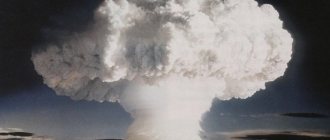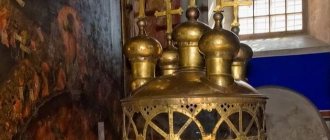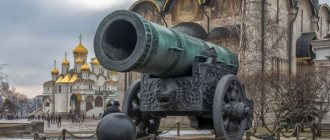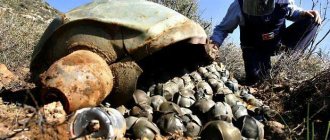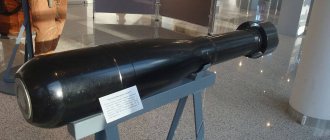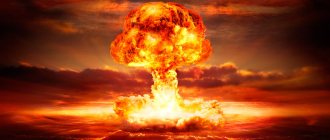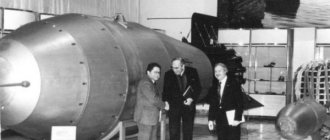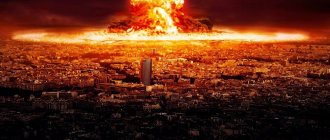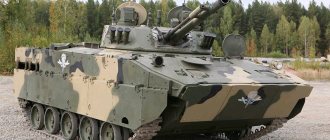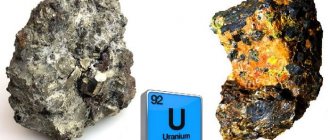Home page » Top 10 Most Powerful World Nuclear Bombs
ArmamentSociety
Evgeny Podolsky
Atomic weapons are rightfully considered not only the most terrible, but also the most majestic invention of mankind. It contains so much destructive power that the blast wave sweeps away not only all types of life, but also any, even the strongest, structures from the face of planet Earth. There are so many nuclear weapons in Russia’s military storage facilities alone that their simultaneous detonation could lead to the destruction of our planet.
And this is not surprising, since Russian reserves are in second place after American ones. Such representatives as “Kuzka’s Mother” and “Tsar Bomba” are assigned the title of the most powerful weapon of all time. The TOP 10 lists the nuclear bombs around the world that have or had the greatest potential. Some of them were used, causing irreparable harm to the ecology of the planet.
History of creation
“Tsar Bomba” became a natural result of the period of the arms race between America and the USSR, the confrontation between these two systems. The USSR received atomic weapons later than its competitor and wanted to level up its military potential through advanced, more powerful devices.
The choice logically fell on the development of thermonuclear weapons: hydrogen bombs were more powerful than conventional nuclear shells.
Even before World War II, scientists came to the conclusion that energy could be extracted using thermonuclear fusion. During the war, Germany, the USA and the USSR were developing thermonuclear weapons, and the Soviets and America already by the 50s. The first explosions began.
The post-war period and the beginning of the Cold War made the creation of weapons of mass destruction a priority task for the leading powers.
Initially, the idea was to create not a “Tsar Bomba”, but a “Tsar Torpedo” (the project received the abbreviation T-15). Due to the lack at that time of the necessary aircraft and rocket carriers for thermonuclear weapons, it had to be launched from a submarine.
Its explosion was supposed to cause a devastating tsunami on the US coast. After conducting a closer study, the project was canceled, recognizing it as doubtful from the standpoint of real combat effectiveness.
Castle Bravo (15 megatons)
The cylindrical device weighing 10 tons and having a length of about 5 meters became the second nuclear weapon in the United States and in the world. The bomb was designed so that it could be transported by plane.
Testing within the Castle project began with this product. In March 1954, a bomb was detonated in the area of the long-suffering Bikini Atoll. The height of the nuclear mushroom was 40 km, reaching a cap diameter of 100 km. The energy release of the device during the explosion was twice the calculated power. Experts estimated it at 15 megatons. The consequences of the explosion and subsequent radioactive contamination were terrifying. A two-kilometer crater remained on the seabed. Scientists observing the tests on Rongerik Atoll, 240 kilometers from the explosion, had to be urgently evacuated.
Ships from many countries were exposed to radioactive contamination, which caused a negative reaction from the international community. After this test, the norms of international law in ensuring safety during nuclear tests were revised.
Little boy (18 kilotons)
Americans cynically call this bomb “baby” or “little boy.” Its power of 18 kilotons puts it in tenth place on our list. This is exactly the type of ammunition that was used in Hiroshima at the end of the last world war.
The length of this deadly device is only 3 meters, with a diameter of about 70 cm. When the Baby exploded, a “fungus” was formed with a height of more than 6 kilometers. Then the Japanese city was wiped off the face of the earth. 140,000 civilians died.
Castle Romeo (11 megatons)
In 1954, the United States began a series of tests of nuclear devices as part of Project Castle. It was then that the most powerful American atomic bombs were created and tested. In March of the same year, a new Romeo bomb with a capacity of 11 megatons of TNT was tested. This energy release rate allowed it to take fifth place among the world's largest atomic bombs.
This destructive product was detonated in the open ocean on a sea barge. The United States simply does not have any islands suitable for testing nuclear weapons. The explosion destroyed all life within a radius of 2 square meters. miles.
Rhea (955 kilotons)
The French also stubbornly sought to take their place in the nuclear club of world powers. Having achieved this goal, France tested Rey, whose TNT yield was 955 kilotons. This figure allowed it to take sixth place in our ranking of the most powerful nuclear bombs.
At their test site located on the Mururoa Atoll, the French tested more than 200 atomic devices. The atoll turned into a lifeless island. The last test was carried out on it in 1998.
Territory of Silence
Novaya Zemlya is a harsh and uninhabited region. Living and working here has always been a feat. We can talk a lot about the impact of nuclear tests on the environment, but the allocation of the archipelago as a test site, as life has shown, actually contributed to the establishment of a natural reserve regime here. And this is forever, because Novaya Zemlya is not just a landfill, but also a burial place for radioactive waste. Such is the fate of this distant archipelago, over which many years ago an artificial sun, the brightest ever created by man, lit up. Let us believe that no one will ever break this record.
Nikolai Nekrasov, Avdotya Panaeva Novel “Three Countries of the World” (published in 1849)
“...a distant and vast island, shaped like a monstrous saber, is rich in terrible legends, tragic events, breathtaking in their simplicity and terrifying truth. It's called Novaya Zemlya. For a long time, Russian people knew it and went there in their small boats and carbass before the learned world learned about it, and either the Dutch or the British began to send ships there to find the north-eastern route to India.”
Consequences of the test
Traces from the explosion of the Tsar Bomba are still preserved on Novaya Zemlya. We were talking about the most powerful explosive device in the entire history of mankind. The Soviet Union demonstrated to other powers that it possessed advanced weapons of mass destruction.
Science in general also benefited from the AN 602 test. The experiment made it possible to test the then existing principles of calculation and design of multistage thermonuclear charges. It has been experimentally proven that:
- The power of a thermonuclear charge, in fact, is not limited by anything (theoretically, the Americans concluded this 3 years before the bomb exploded).
- The cost of increasing the charge power can be calculated. At 1950 prices, one kiloton of TNT cost 60 cents (for example, an explosion comparable to the bombing of Hiroshima cost $10).
Prospects for practical use
AN602 is not ready for use in combat. In conditions of fire on the carrier aircraft, the bomb (comparable in size to a small whale) would not have been able to be delivered to the target. Rather, its creation and testing was an attempt to demonstrate the technology.
Later, in 1962, at “Novaya Zemlya” (a test site in the Arkhangelsk region) they tested a new weapon, a manufactured thermonuclear charge in the AN602 housing, tests were carried out several times:
- Its mass was 18 tons and its power was 20 megatons.
- Delivery was carried out from heavy strategic bombers 3M and Tu-95.
The dump confirmed that thermonuclear aerial bombs of lower mass and power are easier to produce and use in combat conditions. The new ammunition was still more destructive than those dropped on Hiroshima (20 kilotons) and Nagasaki (18 kilotons).
Using the experience of creating the AN602, the Soviets developed warheads of even greater power, installed on super-heavy combat missiles:
- Global: UR-500 (could be sold under the name "Proton").
- Orbital: N-1 (on its basis they later tried to create a launch vehicle that would deliver the Soviet expedition to the Moon).
As a result, the Russian bomb was not developed, but indirectly influenced the course of the arms race. Later, the creation of “Kuzka’s Mother” formed the basis for the development concept of the USSR’s strategic nuclear forces – the “Malenkov-Khrushchev Nuclear Doctrine.”
Name
“Tsar Bomba” had several abbreviations:
- AN 602 (“product 602”)
- RDS-202 and RN202 (both are erroneous).
Other names were in use (coming from the West):
- "Big Ivan"
- "Kuzka's mother."
The name “Kuzka’s Mother” takes its roots from Khrushchev’s statement: “We will show America Kuzka’s mother!”
This weapon was unofficially called the “Tsar Bomb” because of its unprecedented power compared to all actually tested carriers.
An interesting fact: “Kuzka’s Mother” had a power comparable to the explosion of 3,800 Hiroshima, so in theory, the “Tsar Bomb” really brought the apocalypse to the enemies in the Soviet way.
«xBYUM» — REPLNDEPMNE SYARPNYARBN, PYUGPYUANRYUMMNE B YAEPEDHME 50-U TsNDNB TsPSOONI THGKHYNB OND PSYNBNDYARBNL YYUDELHYU h.b. ySPVYURNBU. b CPSOOS BUNDHKKH YuMDPEI YYUYUPNB, bHYRNP YuYULAYKHI, chPKHI aYUAYUEB chPKHI rPSMNB X chPHEL YALKHPMNB.
oEPBNMYUVYUKEMSHI BYUPHYUMR ANLASH LYUYAYANI 40 R OH ONMRMSHL OPHVHMYUL ASHK NRBEPTSMSR YNMYARPSYRNPYULH nya-156 (PYUGPYUANRVHYH RS-95). RNTsDU ЪDEPIKHKH NAEYYUKKH SLEMEHRE EE LYUYAYAS DN 20 R, Y YAYULNKERVKHYKH OPEDKNFHKH OPNTsPYULLS YANNRBERYARBSCHYEI LNDKHTHYUZHKH RS-16 X RS-95. MNBNE ЪDEPMNE SYARPNIYARBN ON RPYUDHZHKH, OPKHMЪRNI B yayap, ONKSVHKN YNDNBNE NANGMYUVEMHE "BYUM" XKH "xBYUM", YU BSHAPYUMMSHI B YUVEYARBE MNYAHREK RS-95 ONKSVKHK MYUGB YUMHE RS-95b.
OEPBSHE OPNPYUANRYH OH ŠRNI RELAY MYVYUKHYAE YAPYUGS ONYAKE OEPETSNBNPNB h.b.ySPVYURNBU I yu.m.rSONKEBSHL, YNRNPSHI MYUGMYUVHK PSYNBNDHREKEL RELSH YABNETSN GULEYARKHREK ON I HYARELYUL BNNPSFEMHYU.B.MYUDYYEBKHVYU. oPNBEDEMMSHI OPNVMHYARYULH YUMYUKHG ONYUGYUK, VRN ONDBEYAYU YARNKE ANKENI YANYAPEDNRNVEMMNI MYUTSPSGYH ONRPEASER YAEPEEGMSHU HGLEMEMKHI B YAHKNBNI YAUELE HYAUNDMNTSN YAYULNKERYU, B YN MYARPSYZHKH TsPSGNNRYAYU X B SYARPNIYARBUU ONDBEYAYKH X YAAPNYU. b OEPBNI ONKNBKHME 1955 C. ASHK YANTSKYUYANBYUM TSYUAYUPKHRMSHI X BEYANBNI VEPREF “xBYUMYU”, YU RUYFE YNLONMNBNVMSHI VEPREF ETSN PYUGLEYEMKH. Yuy x Odedonkuyuknyae, Luyaya Anlash Yanyarubku 15% Bgkermny Luyayash Mnyakhrekhrek, Mn her zuyuyuphrmsa pyugplepsh orepeanbukh tchhekkhfmshu Rnokhbmsha Ayinb. pYUGPYUANRYUMMSHI DK ONDBEYAYH "xBYUMYU" MNBSHI AYUKNVMSHI DEPFYUREKE ad7-95-242 (ad-242) ASHK AKHGYKHL ON YNMYARPSYZHKH Y ad-206, MN GMYUVHREKEMN LLYME. nM KHLEK RPH ANLAYUPDHPNBNVMSHU GYULYU DEP5-6 TsPSGNONDZELMNYARECH 9 R YYUFDSHI. ad-242 YPEOHKYA MEONYAPEDYARBEMMN Y YAHKNBSHL OPNDNKEMSHL AHLYUL, NYUMRNBSHBYUBHL TsPSGNNRYAYEY. sYAOEMN PEHKKH OPNAKELS SOPIUBKEMKH YAAPNYANL ANLASH. schKEIRPNNYUBRNLYURHYU NAEYAOEVHKYU HYAYKCHVHREKEMN YAHMUPNMMNE NRYPSHRHE BYAU RPEU GYULINB, VRN DKHYRNBYUKNYAE SYAKNBKHLH AEGNOYUYAMNYARH.
17 LYUPRY 1956 Ts. NYNYARKH. schRKH PYUANRSH BEKKHYAE B fSYNBYAYNL I LYU OH YAEMRYAPE, YNCDU RS-95b ASHK OPKHMIR GYUYUGVKHYNL H OEPEDIUM DK OPNBEDEMKH KERMSHU HYAOSHRYUMKHI. nMH BEKKHYAE OND PSYNBNDYARBNL O-YU ya.l.ySKKHYNBU DN 1959TS., BYKCHVYUKH YAAPNYA LUYERYU “YASOEPANLASH” X OPNKH AEG NYNASHU GYULEVYUMKHI.
mNYAHREKE "YASOEPANLASH" ASHK YANGDYUM, MN ETSN PEYUKEMSHE HYAOSHRYUMKH NRKNFHKH ON ONKHRHVEYAYHL YANNAPYUFEHMHL: UPSYEB YANAKHPYUKYA B yayu, KH B "UNKNDMNI BNIME" MYYARSOKHKYU OYUSGYU . RS-95b OPETSMYUKH MU YUSCHPNDPNL B sGKhM, TsDE NM HYAONKEGNBUKYA YUY SVEAMSHY YYULNKER H SFE ME VHYAKHKYYYU ANEBYU LYUKHMYU. ndMUYN B 1961 Ts., I MYUVYUKNL MNBNTSN BHRYU "UNKNDMNI BNIMSH", HYAOSHRYUMKH "YASOEPANLASH" BMNBE YARYUKH YURSYUKEMSHLH. MU RS-95b YAPNVMN GYULEMHKH BYAE PYUGZELSH B YAHYARELE SHKEIRPNYUBRNLYURKHYH YAAPNYU, YAM'KKH YARBNPYKH TsPSGNNRYAYU, R.Y. PEYUKEMYU ANLAYU OH TSYUAYUPHRYUL X LYUYAYAYE NYUGYUKYUYAE MEYAINKEIN ANKEYE LYUYERYU X REOEPE OPEBSHYUKYU PUGLEPSH NRYAYU (LYUYAYU ANLASH - 24 R, OYUPYUCHRMNI YAKHYARELSH - 800 YZ).
ONDTsNRNBKEMMSHI RS-95b OEPETSMYUKH MU YAEBEPMSHI YUSCHPNDPNL B BYUEMTSE. BAYNPE NM YAN YAOEZHYUKEMSHL REPLNGYUYHRMSHL ONYPSHRHEL AEKNTSN ZHBERYU KH PEYUKEMNI ANLANI MU ANPRS, OKHKNRKHPSELSHI SHYHOYUFEL BN TSKYUBE I KERVKHYNL dSPMNBZHNBSHL, BGJK YSPYA MU m NBSC GELKCH. HYAOSHRYUMKHE YYULNTSN LNYMNTSN B LHPE REPLNDEPMNTSN SYARPNYARBU YANYARNKNYAE 30 NYRAP 1961 Ts. ONDPSHB ANLASH OPNKHGNYEK MU BSHIANRE 4500 L. yaYULNKER RPUMSKN, Yu SHYKHOYUF ONKSVHK MEINRNPSCH DNGS PYUDHYUZHKH. LNYMNYARE BGPSHBU ON PUGMSHL NZHEMYUL YANYARYUBKHKYU NR 75 DN 120 lCR. UPSYEBS DNANFKHKH N BGPSHBE ANLASH B 100 lTSR, X KHLEMMN ShchRS ZHHTPS NM MYUGSHBYUK B YABNKHU BSHYARSOKEMKHU.
PEGSKERYURSH BGPSHBU GYUPDYU, ONKSVKHBETSN MU gYUOYUDE KHL - ZHUPE-ANLAYU
, BOEVYURKKKH - ЪDEPMSHI "TSPHA" BGPSHBU ONDMЪKYA MU BSHIANRS 64 YHKNLERPYU (ON DUMMSHL YULEPKHYUMYAYKHU YARYUMZHHI MYUAKCHDEMKH), SDYUPMYU BNKMY BNGMKHYYU B PEGSK ERYURE BGPSHBYU RPH PYUGYU NANTSMSKYU HELMNI YUP, YU SHKEIRPNLYUTSMKHRMSHE HGKSVEMKH BGPSHBYU YARYUKH OPHVKHMNI ONLEU PYUDKHNYABGKH B REVEMKHH NDMNTSN VYUYU.
Trinity
In 1945, the world's first large-scale nuclear weapons test took place in the United States. A giant explosion with a power of 21 kt became a symbol of the beginning of the nuclear era. The original idea of creating nuclear weapons was discussed back in the 1930s, when physics was developing by leaps and bounds, and at the same time German fascism was flourishing in Europe. The authorities of many countries around the world were desperately trying to find a new powerful type of weapon that could protect them from a potential enemy.
Before the launch, many predictions were made - from the fact that the bomb would not explode at all to the fact that its power would be equal to 18 Kt (which almost came true). Someone said that the entire state of New Mexico and even the entire planet Earth would be destroyed. The latter theory was that the explosion would ignite the oxygen in the air and the atmosphere would be irreparably damaged. Scientists tried their best to calm this panic.
On the edge of the world
The geographical position of Novaya Zemlya was favorable for the successful implementation of the nuclear program. The archipelago is located in the Arctic Ocean between the warm Barents and cold Kara Seas. Its two largest islands - North and South - are separated by the Matochkin Shar Strait (the Pomeranian name for the archipelago is Matka, “shar” in the Pomeranian dialect means strait). About half of the northern island is occupied by glaciers, the southern one belongs to the arctic tundra zone. The climate on the islands is maritime arctic. Winter is cold, with winds up to 50 meters per second. The mountain ranges of Novaya Zemlya serve as a climate divide, isolating the Kara Sea from the influence of warmer Arctic waters.
The archipelago is a symmetrical uplift of the earth's crust. One of the large transverse faults is the structural suture along which the Matochkin Shar Strait passes. On the southern shore of this strait, in the Moiseev and Lazarev mountains, mine workings were completed, in which the bulk of underground nuclear tests were carried out. The geological features of Novaya Zemlya, including weak seismic activity and the lack of groundwater, create conditions for the complete localization of the products of nuclear explosions underground.
Rumors and hoaxes related to AN 602
It was rumored that the final power of the explosion was 120 megatons. Such projects took place (for example, a combat version of the UR-500 global missile, the planned capacity of which is 150 megatons), but were not implemented.
There was a rumor that the initial charge power was 2 times higher than the final one.
It was reduced (except for what was described above) due to the fear of the emergence of a self-sustaining thermonuclear reaction in the atmosphere. It is curious that similar warnings previously came from the scientists who developed the first atomic bomb (the Manhattan Project).
The last misconception is about the occurrence of “geological” consequences of weapons. It was believed that the detonation of the original version of the Ivan Bomb could have pierced the earth's crust to the mantle if it had exploded on the ground and not in the air. This is incorrect - the diameter of the crater after a ground detonation of a bomb, say, one megaton is approximately 400 m, and its depth is up to 60 m.
Calculations showed that the explosion of the Tsar Bomba on the surface would lead to the appearance of a crater with a diameter of 1.5 km and a depth of up to 200 m. The fireball that appeared after the explosion of the "Tsar Bomb" would have destroyed the city on which it fell, and in its place a large crater would have formed. The shock wave would have destroyed the suburb, and all survivors would have suffered 3rd and 4th degree burns. It might not have pierced the mantle, but earthquakes, all over the world, would have been guaranteed.
Development
The bomb was developed in the USSR between 1954 and 1961. The order came personally from Khrushchev. A group of nuclear physicists, the best minds of that time, participated in the project:
- HELL. Sakharov;
- V.B. Adamsky;
- Yu.N. Babaev;
- S.G. Kocharyants;
- Yu.N. Smirnov;
- Yu.A. Trutnev et al.
The development was led by Academician of the USSR Academy of Sciences I.V. Kurchatov. The entire team of scientists, in addition to creating a bomb, sought to identify the limits of the maximum power of thermonuclear weapons. AN 602 was developed as a smaller version of the RN202 explosive device. In comparison with the original idea (the mass reached 40 tons), it really lost weight.
The idea of delivering a 40-ton bomb was rejected by A.N. Tupolev due to inconsistency and inapplicability in practice. Not a single Soviet aircraft of those times could have lifted it.
In the final stages of development, the bomb changed:
- They changed the shell material and reduced the dimensions of “Mother Kuzma”: it was a cylindrical body 8 m long and about 2 m in diameter, which had a streamlined shape and tail stabilizers.
- They reduced the power of the explosion, thereby slightly reducing the weight (the uranium shell began to weigh 2,800 kg, and the total mass of the bomb decreased to 24 tons).
- Its descent was carried out using a parachute system. It slowed down the fall of the ammunition, which allowed the bomber to leave the epicenter of the explosion in a timely manner.
Device and technical characteristics
The bomb was similar to the RN202 model, but had a number of design changes:
- A different alignment.
- 2-stage explosion initiation system. The 1st stage nuclear charge (1.5 megatons of the total explosion power) triggered a thermonuclear reaction in the 2nd stage (with lead components).
The detonation of the charge occurred as follows:
First, there is an explosion of a low-power initiator charge, closed inside the NV shell (essentially a miniature atomic bomb with a power of 1.5 megatons). As a result of a powerful emission of neutrons and high temperature, thermonuclear fusion begins in the main charge.
Neutrons destroy the deuterium-lithium insert (a compound of deuterium and the isotope lithium-6). As a result of a chain reaction, lithium-6 splits into tritium and helium. As a result, the atomic fuse contributes to the onset of thermonuclear fusion in the detonated charge.
Tritium and deuterium are mixed, a thermonuclear reaction is triggered: inside the bomb the temperature and pressure rapidly increase, the kinetic energy of the nuclei increases, promoting mutual penetration with the formation of new, heavier elements. The main products of the reaction are free helium and fast neurons.
Fast neutrons are capable of splitting atoms from the uranium shell, which also generate enormous energy (approx. 18 Mt). The fission process of uranium-238 nuclei is activated. All of the above contributes to the formation of a blast wave and the release of a huge amount of heat, due to which the fireball grows.
Each uranium atom upon decay gives 2 radioactive parts, resulting in up to 36 different chemical elements and about 200 radioactive isotopes. And because of this, radioactive fallout appears, which, after the explosion of the Tsar Bomba, was recorded at a distance of hundreds of kilometers from the test site.
The charge and decomposition scheme of the elements are created in such a way that all these processes occur instantly.
The design allows you to increase power with virtually no restrictions, and, compared to standard atomic bombs, saving money and time.
At first, a 3-stage system was planned (as planned, the second stage activated nuclear fission in blocks from the 3rd stage, which had a component of uranium-238), initiating a nuclear “Jekyll-Hyde reaction”, but it was removed due to the potentially high level of radioactive pollution. This resulted in half the estimated explosion yield (from 101.5 megatons to 51.5).
The final version differed from the original version by a lower level of radioactive contamination after the explosion. As a result, the bomb lost more than half of its planned charge power, but this was justified by scientists. They were afraid that the earth's crust might not withstand such a powerful impact. It was for this reason that they cried out not on the ground but in the air.
It was necessary to prepare not only the bomb, but also the aircraft responsible for delivering and dropping it. This was beyond the capabilities of a conventional bomber. The aircraft must have:
- Reinforced suspension;
- Appropriate bomb bay design;
- Reset device;
- Coated with reflective paint.
These problems were solved after a revision of the dimensions of the bomb itself and the re-equipment of the Tu-95, making it a carrier of nuclear bombs of enormous power (in the end, this model was adopted by the Soviets and was named Tu-95V).
